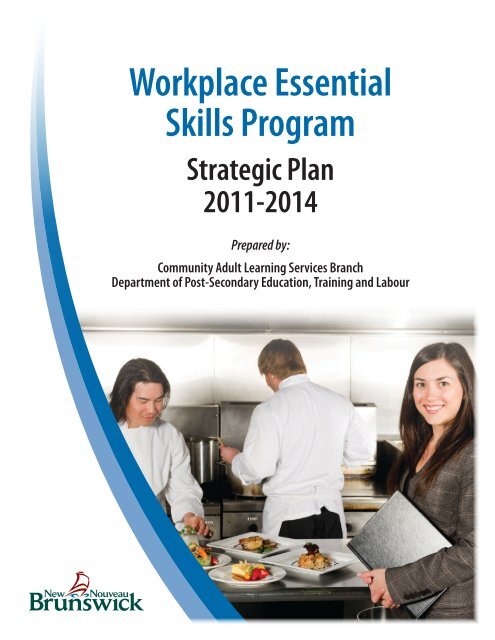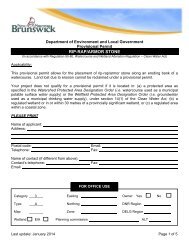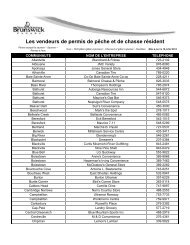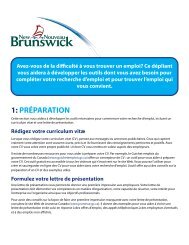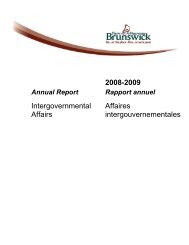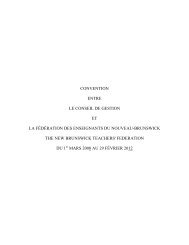Workplace Essential Skills Program - Government of New Brunswick
Workplace Essential Skills Program - Government of New Brunswick
Workplace Essential Skills Program - Government of New Brunswick
You also want an ePaper? Increase the reach of your titles
YUMPU automatically turns print PDFs into web optimized ePapers that Google loves.
<strong>Workplace</strong> <strong>Essential</strong><br />
<strong>Skills</strong> <strong>Program</strong><br />
Strategic Plan<br />
2011-2014<br />
Prepared by:<br />
Community Adult Learning Services Branch<br />
Department <strong>of</strong> Post-Secondary Education, Training and Labour
“Education is not the filling <strong>of</strong> a pail, but the lighting <strong>of</strong> a fire”<br />
William Butler Yeats
Table <strong>of</strong> Contents:<br />
Introduction 2<br />
Definition <strong>of</strong> <strong>Essential</strong> <strong>Skills</strong> 3<br />
Benefits 3<br />
Secondary Benefits 4<br />
Priorities 5<br />
Priority 1 - Increase reach and capacity 5<br />
Priority 2 - Clarify measures <strong>of</strong> success and establish key performance indicators 7<br />
Priority 3 - Further improve quality and effectiveness <strong>of</strong> existing service delivery 8<br />
Priority 4 - Develop and enhance strategic partnerships 10<br />
Measuring Progress 11
<strong>Workplace</strong> <strong>Essential</strong> <strong>Skills</strong> <strong>Program</strong> Strategic Plan<br />
Introduction<br />
Development <strong>of</strong> the <strong>Workplace</strong> <strong>Essential</strong> <strong>Skills</strong> (WES) program began in the fall <strong>of</strong> 2009 in<br />
response to the reported low levels <strong>of</strong> literacy in the existing <strong>New</strong> <strong>Brunswick</strong> workforce 1 and<br />
indicators <strong>of</strong> a growing skills gap in the province as a result <strong>of</strong> changing labour demands.<br />
The WES program <strong>of</strong>fers an accelerated path for lower-skilled adults to gain the knowledge<br />
and skills they require for employment. The program aims to assist individuals who are<br />
employed and those who are actively seeking employment by providing a framework to<br />
acquire or enhance essential skills needed in today’s labour market.<br />
The Department <strong>of</strong> Post-Secondary Education, Training and Labour (PETL) has implemented<br />
and manages program delivery through a network <strong>of</strong> regional WES teams. Two Centres <strong>of</strong><br />
Excellence (one for each <strong>of</strong>ficial language) have been established in Collège communautaire<br />
du Nouveau <strong>Brunswick</strong> (CCNB), Bathurst and <strong>New</strong> <strong>Brunswick</strong> Community College (NBCC),<br />
Saint John. The goal is to support the program through specialized expertise in such areas as<br />
the development <strong>of</strong> learning content, prior-learning assessment, measurement, evaluation,<br />
and in providing other related tools and services.<br />
Private sector partners include employers, business and industry associations, sector councils,<br />
unions, and non-governmental literacy organizations.<br />
An implementation evaluation 2 was conducted in 2010, and the final report was submitted in<br />
February 2011. The main objectives <strong>of</strong> the evaluation were to: a) focus on achieving outputs<br />
and, where feasible, immediate outcomes; b) evaluate the extent to which the program is<br />
meeting the needs <strong>of</strong> its target beneficiaries; and c) evaluate the overall effectiveness <strong>of</strong> the<br />
current approaches to program delivery and design.<br />
In addition to making a number <strong>of</strong> recommendations for improvement, the report<br />
highlighted many accomplishments and strengths. It concluded that the training provided<br />
meets the needs <strong>of</strong> the target groups and both learner and employer-focused outcomes have<br />
been met. This is supported by ongoing evaluation data which indicates that employers and<br />
learners are generally satisfied with the services provided and cite many positive outcomes.<br />
The findings <strong>of</strong> the implementation evaluation and feedback from program staff, partners<br />
and stakeholders were taken into consideration within this strategic planning process. Steps<br />
were also taken to ensure that the WES Strategic Plan is driven by and consistent with the<br />
priorities outlined within Working Together for Adult Literacy: An Adult Literacy Strategy for <strong>New</strong><br />
<strong>Brunswick</strong>.<br />
1<br />
Building on our Competencies: Canadian Results <strong>of</strong> the International Adult Literacy and <strong>Skills</strong> Survey, 2003; Human<br />
Resources and <strong>Skills</strong> Development Canada and Statistics Canada<br />
2<br />
Implementation Evaluation <strong>of</strong> the NB <strong>Workplace</strong> <strong>Essential</strong> <strong>Skills</strong> (WES) <strong>Program</strong>, February 2011; Goss Gilroy Inc.,<br />
Ottawa<br />
2
<strong>Workplace</strong> <strong>Essential</strong> <strong>Skills</strong> <strong>Program</strong> Strategic Plan<br />
Definition <strong>of</strong> <strong>Essential</strong> <strong>Skills</strong><br />
<strong>Essential</strong> skills are the foundational skills required to successfully participate in the Canadian<br />
labour market. They help people perform the tasks required by their occupation, provide<br />
people with a foundation for learning other skills, and enhance people’s ability to innovate<br />
and adapt to workplace change. 3 <strong>Essential</strong> skills include:<br />
• Reading – reading materials in the form <strong>of</strong> sentences and paragraphs<br />
• Document Use – tasks that involve a variety <strong>of</strong> information displays in which words,<br />
numbers, symbols and other visual characteristics (e.g. lines, colours or, shapes) are given<br />
meaning by their spatial arrangement<br />
• Numeracy – using numbers and thinking in quantitative terms to complete tasks<br />
• Writing – writing text and writing in documents, such as filling in forms, and non-paperbased<br />
writing, such as typing on a computer<br />
• Oral Communication – using speech to give and exchange thoughts and information<br />
• Working with Others – employees working with others to carry out their tasks<br />
• Thinking – The process <strong>of</strong> evaluating ideas or information to reach a rational decision<br />
• Computer Use – using different kinds <strong>of</strong> computer applications and other related technical<br />
tools<br />
• Continuous Learning – Worker’s participation in an ongoing process <strong>of</strong> acquiring skills and<br />
knowledge<br />
The International Adult Literacy <strong>Skills</strong> Survey (IALSS), 2003, measured pr<strong>of</strong>iciency across four<br />
<strong>of</strong> these domains (essential skills), grouping scores into pr<strong>of</strong>iciency levels one through five.<br />
Within the study, level three was defined as the “desired level” <strong>of</strong> competence, <strong>of</strong>ten referred<br />
to as “functional level” i.e. the level that enables adults to function adequately at home, at<br />
work and in their communities.<br />
Benefits<br />
Within the workplace, companies have consistently<br />
reported the following types <strong>of</strong> benefits <strong>of</strong> workplace<br />
essential skills training:<br />
• improved product/service quality<br />
• improved health and safety practices<br />
• improved recruitment and retention<br />
• improved communication amongst team members.<br />
3<br />
<strong>Essential</strong> <strong>Skills</strong>: <strong>Skills</strong> to Build On, 2007; Human Resources and Social Development Canada<br />
3
<strong>Workplace</strong> <strong>Essential</strong> <strong>Skills</strong> <strong>Program</strong> Strategic Plan<br />
Companies also indicated increased employee confidence, leading to greater employee<br />
engagement and increased ability to undertake further training. This contributes to greater<br />
productivity and flexibility, and ultimately economic competitiveness and success.<br />
Additionally, those seeking employment cited benefits such as increased confidence when<br />
seeking employment, access to work experience and jobs. And, there is evidence from both<br />
employed and unemployed learners that an interest in continued and further learning is also<br />
a common, positive outcome.<br />
The WES <strong>Program</strong><br />
Vision<br />
All current and potential employees in <strong>New</strong> <strong>Brunswick</strong> gain the essential skills they need to<br />
meet the changing demands <strong>of</strong> the workplace.<br />
Target group<br />
The WES program has two distinct target client groups – individuals who are already<br />
employed and those who are actively seeking employment (employables). The table below<br />
defines the program target groups in more detail.<br />
Employed<br />
Employable<br />
Adults with:<br />
• below functional level (level 3) skills in<br />
one or more essential skills, including at<br />
least one <strong>of</strong> the core literacy skills 4<br />
Note: Additional focus is on occupations<br />
within targeted priority sectors 5<br />
Adults (aged 18 and over) who:<br />
• are case managed 6<br />
• have an occupational goal, and<br />
• have a skill gap in one or more entry<br />
level essential skills, including at least one<br />
<strong>of</strong> the core literacy skills<br />
Secondary Beneficiaries<br />
Although the learners are the primary beneficiaries <strong>of</strong> this program, there is also a clear,<br />
secondary beneficiary group - that <strong>of</strong> employers.<br />
4<br />
Core Literacy <strong>Skills</strong>: Document Use, Reading , Writing, Numeracy<br />
5<br />
Targeted priority sectors: 1) Trade, finance, insurance, real estate and leasing; 2) Manufacturing; 3) Health care<br />
and social assistance; 4) Construction; 5) Accommodation and Food Services; as defined in Literacy in <strong>New</strong><br />
<strong>Brunswick</strong>; Implications <strong>of</strong> findings from IALSS 2003, 2006, Learning Policy Directorate, Human Resources and <strong>Skills</strong><br />
Development Canada<br />
6<br />
Referred by Employment Development, Social Development, Public Safety or Worksafe NB.<br />
4
<strong>Workplace</strong> <strong>Essential</strong> <strong>Skills</strong> <strong>Program</strong> Strategic Plan<br />
The employer focus for employed learners is small and medium-sized businesses. Incubation<br />
services 7 only will be <strong>of</strong>fered to large employers and government agencies. For initiatives<br />
targeting employable individuals, the employer focus will be determined according to<br />
regional labour needs.<br />
Products/Services<br />
The following table outlines the products/services that the WES program <strong>of</strong>fers to <strong>New</strong><br />
<strong>Brunswick</strong>ers, and what differentiates them from other training or essential skills training<br />
options:<br />
Service/product<br />
Employed<br />
Tools, resources and expertise<br />
for employers and employees,<br />
to encourage and facilitate adult<br />
learning opportunities in workrelated<br />
essential skills<br />
Employable<br />
Tools, resources and expertise<br />
to facilitate adult learning<br />
opportunities in work-related<br />
essential skills, as a pathway<br />
to further education or<br />
employment<br />
Differentiator<br />
Focus on adults with low literacy and essential skills levels<br />
Priorities<br />
A number <strong>of</strong> strategic priorities have been identified to support the vision:<br />
1. Increase reach and capacity<br />
2. Clarify measures <strong>of</strong> success and establish key performance indicators<br />
3. Further improve quality and effectiveness <strong>of</strong> service delivery<br />
4. Develop and enhance strategic partnerships<br />
Priority 1: Increase reach and capacity Ref: 8 WTP 1, 2<br />
The initial roll-out <strong>of</strong> the WES <strong>Program</strong> was met with significant demand from employers and<br />
learners which has exceeded the capacity <strong>of</strong> some regions. In order to reach more adults with<br />
a range <strong>of</strong> essential skills levels and needs, different motivations and different circumstances,<br />
it is important to <strong>of</strong>fer a diversity <strong>of</strong> learning opportunities in a variety <strong>of</strong> environments.<br />
7<br />
The provision <strong>of</strong> tools, resources and expertise to initiate and nurture the development <strong>of</strong> workplace<br />
essential skills training as an integral feature <strong>of</strong> workplace learning within an organization, with<br />
the aim <strong>of</strong> the employer taking ownership <strong>of</strong> and facilitating WES training on an ongoing basis.<br />
8<br />
Each priority is cross-referenced to the associated Working Together for Adult Literacy: An Adult Literacy<br />
Strategy for <strong>New</strong> <strong>Brunswick</strong> priority (WTP).<br />
5
<strong>Workplace</strong> <strong>Essential</strong> <strong>Skills</strong> <strong>Program</strong> Strategic Plan<br />
Objectives:<br />
1. Explore and develop alternative options for service delivery through:<br />
• Strategic partnerships<br />
• Embedding essential skills training within other training opportunities<br />
• Diverse tools and approaches<br />
The work setting provides a wealth <strong>of</strong> relationships and contexts (e.g. unions, trade<br />
associations, mentors and coaches etc.) which will be utilized to enhance access to<br />
workplace essential skills training. Key partnerships will be developed in a controlled<br />
manner to test alternative models <strong>of</strong> delivery, such as provincial partnerships, incubation<br />
<strong>of</strong> services within larger companies, and “hub” models (training for learners from small<br />
and medium-sized businesses with similar essential skill needs or coming from similar<br />
occupational pr<strong>of</strong>iles).<br />
<strong>Essential</strong> skills do not stand alone. They represent the foundation for all other learning and<br />
skills development. Opportunities to embed essential skills development within existing,<br />
formal and informal learning situations, and to address essential skills challenges in the<br />
routine work context, will be explored and developed.<br />
Diversity <strong>of</strong> programming, flexibility in delivery methods and relevant, contextualized<br />
resources are all important to encouraging adults to take up opportunities to develop their<br />
skills. Informed by a literature review <strong>of</strong> barriers to adult learning, new, innovative delivery<br />
approaches for both level one and level two 9 learners will be explored. A small number<br />
deemed to have potential for success in the <strong>New</strong> <strong>Brunswick</strong> context will be identified for<br />
testing.<br />
2. Develop infrastructure to support shared ownership <strong>of</strong> workplace essential skills<br />
training<br />
One <strong>of</strong> the most significant developments within the WES program is that <strong>of</strong> strategic<br />
partnerships to foster new, innovative and collaborative approaches to the provision<br />
<strong>of</strong> essential skills training. This implies, in some cases, that ownership <strong>of</strong> essential skills<br />
services will be shared with non-government organizations.<br />
In this environment, it is important that the WES program define and develop the<br />
appropriate mechanisms for assuring quality, consistency and communication across all<br />
stakeholders.<br />
PETL has already developed a Quality Framework for Adult Literacy and <strong>Essential</strong> <strong>Skills</strong><br />
Service Delivery in <strong>New</strong> <strong>Brunswick</strong> (see priority 3) and will take measures to ensure that all<br />
new service delivery partners are accountable within the terms <strong>of</strong> this framework.<br />
9<br />
IALSS pr<strong>of</strong>iciency levels<br />
6
<strong>Workplace</strong> <strong>Essential</strong> <strong>Skills</strong> <strong>Program</strong> Strategic Plan<br />
3. Develop awareness <strong>of</strong> work-related essential skills needs<br />
Experience to date shows that employer awareness <strong>of</strong> literacy and essentials skills needs is<br />
limited and that learners lack awareness <strong>of</strong> their need to improve their skills. Best practice<br />
from other jurisdictions will guide effective approaches to meeting these challenges and<br />
raising awareness across all stakeholders.<br />
4. Ensure a clearly defined budget that is allocated in accordance with the requirements<br />
<strong>of</strong> the funding sources and provides adequate funding for the two target groups<br />
At present, and until March 2014, the Canada <strong>New</strong> <strong>Brunswick</strong> Labour Market Agreement<br />
(LMA) provides funding for programs targeting employed individuals. Current funding for<br />
unemployed individuals is limited, thereby constraining services for this target group.<br />
PETL will continue to work towards ensuring appropriate funding for both target groups.<br />
5. Maximize employer contributions as part <strong>of</strong> funding model<br />
Some employers do currently invest in the WES training for their employees through<br />
monetary and in-kind contributions <strong>of</strong> employee paid time for assessment and/or training,<br />
training space etc. However, it is important to continue to focus on encouraging as much<br />
<strong>of</strong> an employer contribution as possible to encourage ownership, foster a culture <strong>of</strong><br />
workplace learning and work towards sustainability.<br />
Priority 2: Clarify measures <strong>of</strong> success and establish key performance<br />
indicators<br />
Ref: 10 WTPAs<br />
As development <strong>of</strong> the program has progressed, it has become apparent that essential skills<br />
training is not the only service <strong>of</strong>fered with value to learners and/or employers. Occupational<br />
pr<strong>of</strong>iles, training needs assessments and individual learning plans also seem to have<br />
significant value as discrete deliverables. The program team will explore this concept in more<br />
detail to clearly define the value proposition for each program deliverable. Over time, it has<br />
also become apparent that different stakeholders have different measures <strong>of</strong> success. We will<br />
analyze these different measures, determine which <strong>of</strong> them are appropriate and measurable,<br />
and ensure that they are reflected in the program evaluation framework. We will establish key<br />
performance indicators to monitor progress and success.<br />
Objectives:<br />
1. Establish and communicate well-defined measures <strong>of</strong> success<br />
A clear understanding <strong>of</strong> measures <strong>of</strong> success and the development <strong>of</strong> key performance<br />
indicators is vital to fully and clearly demonstrate the value <strong>of</strong> the program to all<br />
stakeholders.<br />
10<br />
Each priority is cross-referenced to the associated Working Together for Adult Literacy: An Adult Literacy Strategy<br />
for <strong>New</strong> <strong>Brunswick</strong> priority (WTP).<br />
7
<strong>Workplace</strong> <strong>Essential</strong> <strong>Skills</strong> <strong>Program</strong> Strategic Plan<br />
Initially, a comprehensive evaluation framework was established for the WES program,<br />
covering different measures and requiring significant amounts <strong>of</strong> data to be captured,<br />
recorded and reported. Once the program was underway, it became clear that different<br />
partners had their own definition <strong>of</strong> success for their client group. There are also<br />
challenges with evaluation tools and, additionally, changes to evaluation tools have further<br />
complicated this area. The development <strong>of</strong> alternative delivery models where the WES<br />
program facilitates others to lead the actual delivery will likely present further challenges.<br />
We will communicate performance indicators through regular and frequent<br />
communication with stakeholders.<br />
2. Achieve appropriate balance between administration, coordination and service<br />
delivery<br />
The current service delivery model is proving to be administration-heavy. Initial<br />
calculations <strong>of</strong> cost per learner indicate that this delivery model is comparatively costly.<br />
However, this calculation is based on a simple measure <strong>of</strong> number <strong>of</strong> learners and does not<br />
take into account other potential deliverables.<br />
We will review the cost per learner measure and refine, as appropriate. We will develop<br />
measures to streamline processes to find efficiencies in administration, coordination and<br />
service delivery.<br />
Priority 3: Further improve quality and effectiveness <strong>of</strong> service delivery<br />
Ref: 11 WTP 3<br />
PETL launched the Quality Framework for Literacy and <strong>Essential</strong> <strong>Skills</strong> Service Delivery in<br />
<strong>New</strong> <strong>Brunswick</strong> (Quality Framework) in February 2011. The framework applies to all adult<br />
literacy and essential skills service delivery undertaken by, on behalf <strong>of</strong>, or funded by the<br />
<strong>Government</strong> <strong>of</strong> <strong>New</strong> <strong>Brunswick</strong>. The framework includes a set <strong>of</strong> quality standards and a<br />
quality assurance model outlining operational support for quality assessment, internal<br />
assessment and external assessment. This enables program staff and service delivery<br />
partners to gain an understanding <strong>of</strong> quality as it relates to literacy and essential skills<br />
service delivery.<br />
The framework will help identify strengths and weaknesses in relation to the standards and<br />
provides an access point for support to meet these standards.<br />
Additionally, learners have a right to expect meaningful outcomes from their learning and<br />
for their learning to be recognized within relevant jurisdictions. Wherever possible, learning<br />
should result in recognition and certification that is widely accepted and transferable.<br />
There should also be clearly defined learning pathways so they can make informed choices<br />
consistent with their goals.<br />
11<br />
Each priority is cross-referenced to the associated Working Together for Adult Literacy: An Adult Literacy Strategy<br />
for <strong>New</strong> <strong>Brunswick</strong> priority (WTP).<br />
8
<strong>Workplace</strong> <strong>Essential</strong> <strong>Skills</strong> <strong>Program</strong> Strategic Plan<br />
Through the next phase <strong>of</strong> implementation <strong>of</strong> the Quality Framework, we will undertake<br />
initial pilot projects for mentored internal assessment. These will include WES service<br />
delivery in one region. The goal is to develop an internal assessment guide and tools, which<br />
will be provided to all those involved in service delivery.<br />
Objectives:<br />
1. Develop a detailed quality improvement plan, to include:<br />
a. Processes/tools for monitoring quality – especially <strong>of</strong> end-user experience<br />
(training)<br />
In alignment with the implementation <strong>of</strong> the Quality Framework 12 , a number <strong>of</strong><br />
processes/tools have been developed by the Centres <strong>of</strong> Excellence to assure consistent<br />
quality <strong>of</strong> service delivery across all regions.<br />
b. Standards – consistency, administration<br />
Given the fast pace <strong>of</strong> development over the last 18 months, administrative guidelines,<br />
processes and tools have changed frequently, leading to some inconsistency across<br />
the regions. We will reaffirm standards and review and revise guidelines. To ensure a<br />
common understanding, all changes and revisions will be communicated to staff.<br />
c. Assessment<br />
Having worked with processes and tools for the different levels <strong>of</strong> assessment, regional<br />
staff has identified issues <strong>of</strong> continuity and integrity as it relates to adult learning<br />
principles. We will undertaken a holistic review <strong>of</strong> assessment within the program and<br />
develop recommendations for improvement.<br />
d. Application <strong>of</strong> Prior Learning Assessment and Recognition (PLAR)<br />
Processes and tools are at various stages <strong>of</strong> development for the appropriate and<br />
effective use <strong>of</strong> PLAR within the program. We will assign resources to continue to focus<br />
on developing this area, using established best practices as benchmarks.<br />
e. Learning resources – more appropriate, contextualized<br />
Given the relatively short duration <strong>of</strong> WES interventions, it is important to ensure that<br />
the training is as focused and relevant as possible. One key element <strong>of</strong> this is learning<br />
materials that are contextualized to the work environment/s <strong>of</strong> learners. Over time,<br />
a database <strong>of</strong> contextualized resources has been developed, but each new initiative<br />
brings challenges in this area. We will continue to develop and provide a selection <strong>of</strong><br />
materials for different sectors and types <strong>of</strong> business.<br />
12<br />
Quality Framework for Adult Literacy and <strong>Essential</strong> <strong>Skills</strong> Service Delivery in <strong>New</strong> <strong>Brunswick</strong>, 2011<br />
9
<strong>Workplace</strong> <strong>Essential</strong> <strong>Skills</strong> <strong>Program</strong> Strategic Plan<br />
2. Develop sustainable pr<strong>of</strong>essional development model for WES staff and 3 rd party<br />
service providers<br />
The quality <strong>of</strong> service delivery depends largely on the skills and knowledge <strong>of</strong> the staff<br />
providing those services. We will continue to support pr<strong>of</strong>essional development and<br />
facilitate sharing <strong>of</strong> best practices and success stories, on an ongoing basis.<br />
3. Develop WES as an accepted entry requirement to post-secondary institutions<br />
To be meaningful to learners, WES training needs to be part <strong>of</strong> an accepted pathway to<br />
post-secondary education and/or employment. CCNB and Apprenticeship & Occupational<br />
Certification are currently undertaking pilots whereby WES training is provided as a precursor<br />
to pre-employment training 13 . The objective <strong>of</strong> these pilots is to determine if WES<br />
training prepares an adult for pre-employment training as well as or better than other<br />
entry pathways. We will develop a detailed plan to map out the remaining steps required<br />
to move towards full acceptance <strong>of</strong> the appropriateness <strong>of</strong> WES training as a learning<br />
pathway.<br />
4. Work towards accreditation <strong>of</strong> WES training<br />
The WES training pilot project at CCNB Bathurst has been developed in such a way as to<br />
meet the standards required by CCNB for certification. We will continue to explore the<br />
viability and options relating to accreditation <strong>of</strong> WES training.<br />
Priority 4: Develop and enhance strategic partnerships Ref: 14 WTP 4<br />
Stakeholders from government, industry, business, labour and community can all play a<br />
role in the potential success <strong>of</strong> WES training. Although some strong partnerships have been<br />
developed regionally, we will work to develop and enhance strategic partnerships at both<br />
provincial and regional levels.<br />
Objectives:<br />
1. Align partnerships with strategic direction<br />
A lack <strong>of</strong> clarity exists regarding the mutual expectations <strong>of</strong> strategic partners. We will work<br />
towards clarifying respective roles and responsibilities, levels <strong>of</strong> accountability, expected<br />
outcomes, etc.<br />
2. Improve linkages with adult literacy and essential skills partners<br />
In recognition that learners have different needs and varied situations, we will provide a<br />
range <strong>of</strong> pathways to improving skills. Community-based adult literacy and essential skills<br />
partners can <strong>of</strong>fer alternatives to and support for WES training. We will improve linkages in<br />
order to serve learners better.<br />
13<br />
CCNB pilots are focused on pre-employment courses that currently require High School Diploma, an<br />
Adult High School Diploma, or a Diploma <strong>of</strong> High School Equivalency (GED) as an entry requirement.<br />
14<br />
Each priority is cross-referenced to the associated Working Together for Adult Literacy: An Adult Literacy Strategy<br />
for <strong>New</strong> <strong>Brunswick</strong> priority (WTP).<br />
10
<strong>Workplace</strong> <strong>Essential</strong> <strong>Skills</strong> <strong>Program</strong> Strategic Plan<br />
3. Ensure consistent and reliable communication with stakeholders<br />
Experience to date has highlighted the challenges and importance <strong>of</strong> persistent and timely<br />
communication across all stakeholders. We will further develop communication protocols<br />
to address these challenges.<br />
Measuring Progress<br />
As outlined earlier, we will work towards clarifying meaningful measures <strong>of</strong> success and<br />
ensuring that we have the tools and processes in place to record and report on progress. We<br />
will review the current evaluation framework that drives the capture <strong>of</strong> both quantitative and<br />
qualitative data.<br />
With regard to the strategic priorities outlined in the <strong>Workplace</strong> <strong>Essential</strong> <strong>Skills</strong> Strategic Plan,<br />
relevant areas for measures <strong>of</strong> success would include:<br />
• Detailed action plan to support the strategy<br />
• Learner participation<br />
• Employer participation<br />
• Strategic partnerships<br />
• Shared ownership <strong>of</strong> WES service delivery<br />
• Employer investment in WES initiatives<br />
• Number and diversity <strong>of</strong> learning options<br />
• Innovative programming<br />
• Implementation <strong>of</strong> the Quality Framework for Adult Literacy and <strong>Essential</strong> <strong>Skills</strong><br />
Service Delivery<br />
• Learners gaining recognized and/or accredited learning outcomes<br />
• Key performance indicators for the WES program<br />
• Reporting mechanisms for provincial progress against pre-defined goal targets and/or<br />
performance measures, as they pertain to the strategy<br />
• Improved quality.<br />
Action Plan<br />
A detailed provincial action plan has been developed to support the WES Strategic Plan. The<br />
provincial action plan will feed each WES regional action plan, helping in the determination <strong>of</strong><br />
specific targets and objectives for each regional WES team.<br />
11


